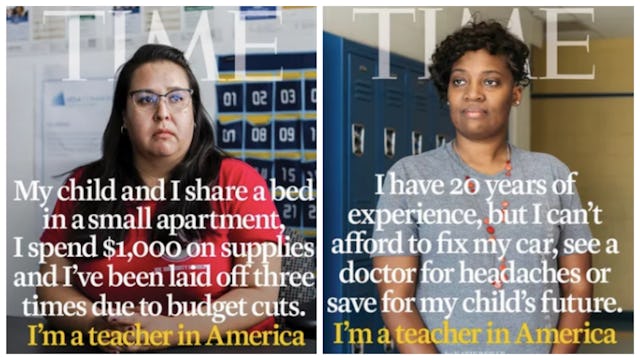New Time Magazine Covers Show What It's Like To Be A Teacher In America

A full-time public school teacher should be making a livable wage, full stop
It’s often said that teaching can feel like a thankless job. The new TIME magazine cover story series shows just how thankless being a teacher in America is — and the stories featured are a sobering reminder of how deeply we fail our country’s teachers, every single day.
High school history teacher Hope Brown donates plasma twice a week and regularly consigns her clothing to make ends meet. NaShonda Cooke, a middle school teacher in North Carolina, says she often skips doctor’s appointments to save on high co-pay costs and struggles to pay utility bills. The thing is — this is the daily reality for many teachers across the country. Living on meager salaries, shelling out crippling amounts of their own money for classroom supplies, and struggling to make ends meet. Even though they’re working full-time jobs and pulling in more hours than the average American worker, not to mention shaping the minds and lives of our youth.
According to the Department of Education, today’s full-time public school teachers are experiencing some of the worst wage stagnation of any profession. Teachers earn less on average now than they did in 1990 (when adjusted for inflation). TIME reports the pay gap between teachers and other, similarly educated professionals is officially the largest gap on record. For comparison’s sake, public school teachers in 1994 earned 1.8% less per week than other workers with the same education. As of 2017, they are now making 18.7% less.
That’s HUGE. Why are we failing our country’s teachers — and by default, our children — so astronomically? And before anyone chimes in with “well what about June, July, and August” please hold your breath, because no teacher gets three full months “off.” That’s not a thing. They also juggle lesson planning, buying supplies, and classroom preparation in the summertime, too. Teachers’ jobs don’t stop once your child gets on the bus to go home.
Apparently, the decline in education funding isn’t limited to salaries. Many public schools are dilapidated, overcrowded, and reliant on outdated teaching materials and using threadbare supplies. Politics plays a role too, of course. With many constituents and politicians at war with public education and frustrated with teachers’ unions, curriculum, and budgets, charter schools have become a widespread alternative to traditional public schools. Charter schools are publicly funded, but privately operated, which can cut teachers’ pensions and benefits.
This year, we’ve seen major teachers’ strikes all over the country as teachers everywhere fight for a living wage, better benefits, and basic necessities in the classroom. So what’s the cause behind decades of low pay for our educators? Sexism, according to experts in the piece. Because a majority of teachers are women.
When TIME released the cover series on Twitter, people everywhere quickly weighed in.
Brown, the high school teacher mentioned above, feels she shouldn’t have to sacrifice doing what she loves and what she feels is important. “I’m not necessarily a religious person, but I do believe I was put here to be a teacher,” she says. “I just want to be able to financially do that.”
This article was originally published on